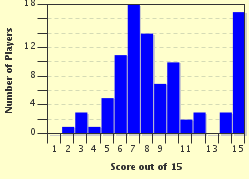Quiz Answer Key and Fun Facts
1. What is the translation normally given to the word 'Blitzkrieg'?
2. In the morning of the 10th May 1940 the Germans invaded the Netherlands, Belgium and Luxembourg. Paratroopers played an important role. What division were these paratroopers organised into?
3. How many Panzer-Divisions were deployed against the Western Powers?
4. In Fall Gelb, the Germans for the first time deployed a 'Panzergruppe'. Who was in command of the original Panzergruppe?
5. Like in the France-Prussian war of 1870-1871, this town again played a vital role in the defeat of France.
6. Of the famous Panzer-Divisions, how many were deployed against Belgium and Luxembourg in Heeresgruppe (Army Group) A?
7. The Germans attacked through the Netherlands and Belgium because the Franco-German border was defended by which defensive line?
8. What was the French counterpart of the German Panzer-Divisions?
9. The French tanks are generally considerd superior to the German panzers, but there was, besides doctrine, one important difference between the French Chars and the German Panzers. What was the most important difference?
10. This man wrote the book "Vers l'armée de métier" ("Towards a Professional Army"), commanded a tank division and later became the leader of the Free French. Who was he?
11. Whom of the following German generals was NOT the leader of an Armoured Corps?
12. After the fall of Dunkirk and the continued German advance, the French capital, Paris, was declared an 'Open City'. On what date did German troops enter Paris?
13. This French commander was the Commander in Chief of all ground forces situated in France. After the German breaktrough he was replaced by General Weygand. Who was he?
14. The armistice was signed in a traincar in which of the following cities?
15. After the Armistice was signed the unoccupied area of France was known as?
Source: Author
Kenny00
This quiz was reviewed by FunTrivia editor
bloomsby before going online.
Any errors found in FunTrivia content are routinely corrected through our feedback system.

